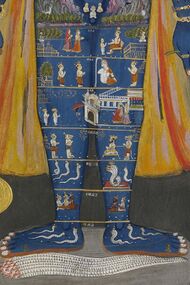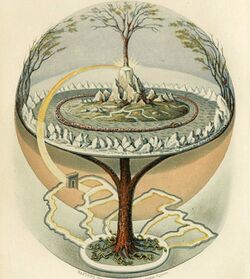Unsolved:Underworld

The underworld is the world of the dead in various religious traditions, located below the world of the living.[1] Chthonic is the technical adjective for things of the underworld.
The concept of an underworld is found in almost every civilization, and "may be as old as humanity itself".[2] Common features of underworld myths are accounts of living people making journeys to the underworld, often for some heroic purpose. Other myths reinforce traditions that entrance of souls to the underworld requires a proper observation of ceremony, such as the ancient Greek story of the recently dead Patroclus haunting Achilles until his body could be properly buried for this purpose.[3] Persons having social status were dressed and equipped in order to better navigate the underworld.[4]
A number of mythologies incorporate the concept of the soul of the deceased making its own journey to the underworld, with the dead needing to be taken across a defining obstacle such as a lake or a river to reach this destination.[5] Imagery of such journeys can be found in both ancient and modern art. The descent to the underworld has been described as "the single most important myth for Modernist authors".[6]
By mythology
This list includes underworlds in various mythology, with links to corresponding articles.
| Albanian mythology | Ferri |
| Aztec mythology | Mictlan |
| Babylonian mythology | Irkalla |
| Buddhist mythology | Patala, Naraka (also Niraya) |
| Celtic mythology | Annwn, Mag Mell |
| Chinese mythology / taoism | Diyu 地獄 |
| Christian mythology | Hell, Tártaro, Purgatory |
| Egyptian mythology | Aaru, Duat, Neter-khertet, Amenti |
| Estonian mythology | Toonela |
| Fijian mythology | Burotu, Murimuria[7] |
| Finnish mythology | Tuonela |
| Georgian mythology | Kveskneli |
| Germanic mythology | Hel, Niflheim |
| Greek mythology | |
| Guanche mythology |
Echeide, Guayota |
| Hindu mythology | Patala, Naraka or Yamaloka |
| Hittite mythology | Dankuš daganzipaš/Dankuš tekan (dark earth) |
| Hopi mythology | Maski |
| Hungarian mythology | Alvilág |
| Inca mythology | Uku Pacha |
| Inuit mythology | Adlivun |
| Islamic mythology | Jahannam (hell), layers of earth: Basit (plain), Thaqil (region of distress), Batih (place of torrents or swamps), Hayn (region of adversity), Sijjin (store or dungeon), As-Saqar (place of burning), Athara (place of great cold) |
| Jain mythology | Naraka, Adho Loka (the lower world) |
| Japanese mythology/Shinto | Yomi 黄泉, Ne-no-Kuni 根の国, Jigoku 地獄 |
| Jewish/Hebrew mythology | Sheol, Gehenna, Abaddon, Tehom (in Kabbalah), Tophet, Tzoah Rotachat, Dudael |
| Korean mythology | "Ji-Ok" 지옥 地獄 |
| Latvian mythology | Aizsaule |
| Malay mythology | Alam Ghaib (The unseen realm) |
| Indonesian mythology | |
| Māori mythology | Hawaiki, Rarohenga, Rangi Tuarea, Te Toi-o-nga-Ranga, Uranga-o-Te-Ra |
| Mapuche mythology | Pellumawida, Degin, Wenuleufu, Ngullchenmaiwe |
| Maya mythology | Metnal, Xibalba |
| Melanesian mythology | (includes Fijian) Bulu, Burotu, Murimuria, Nabagatai, Tuma |
| Norse mythology | Gimlé, Hel, Niflhel, Vingólf |
| Oromo mythology | Ekera |
| Persian mythology | Duzakh |
| Philippine mythology | Kasanaan |
| Polynesian mythology | Avaiki, Bulotu, Iva, Lua-o-Milu, Nga- Atua, Pulotu, Rangi Tuarea, Te Toi-o-nga-Ranga, Uranga-o-Te-Ra |
| Pueblo mythology | Shipap |
| Roman mythology | Inferi, Avernus |
| Romanian mythology | Tărâmul Celălalt |
| Slavic mythology | Nav, Podsvetie, Peklo, Vyraj |
| Sumerian mythology | Kur, Hubur |
| Turko-Mongol | Tamağ |
| Vodou mythology | Guinee |
| Wagawaga (New Guinea) mythology | Hiyoyoa |
Underworld figures
This list includes rulers or guardians of the underworld in various mythologies, with links to corresponding articles.
| Aboriginal mythology | Baiame (Kamilaroi), Eingana |
| Akkadian mythology | Allu, Anu, Anunnaku, Ereshkigal, Etemmu, Gallu, Humbaba, Mamitu, Nergal, Utnapishtim |
| Albanian mythology | E Bukura e Dheut |
| Turko-Mongol | Erlik |
| Armenian mythology | Spandaramet |
| Aztec mythology | Mictlantecuhtli, Mictecacihuatl, Chalmecacihuilt, Chalmecatl |
| Babylonian mythology | Erra, Nergal, Ninlil, Sursunabu, Ur-shanabi, Utnapishtim |
| Balinese mythology | Batara Kala, Setesuyara |
| Bon mythology | gNyan |
| Buddhist mythology | Yama |
| Canaanite mythology | Mot, Arsay |
| Celtic mythology | Aed, Arawn, Cwn Annwn, Donn, Gwyn ap Nudd, Manannán mac Lir, Pwyll |
| Chinese mythology | Gui, Yanluo |
| Christian mythology | Satan, Lucifer, Beelzebub |
| Egyptian mythology | Aken, Aker (strictly only the gatekeeper), Am-heh, Amunet, Ammit, Andjety, Anubis, Apep, Apis, Astennu, Ha, Imiut (if the Imiut was ever considered a god), Isis, Mehen, Naunet, Nehebkau, Nephthys, Nun, Nut, Osiris, Ptah, Seker, Thoth |
| Elamite mythology | Jabru |
| Estonian mythology | Vanapagan |
| Etruscan mythology | Charun, Culsu, Februus, Mania, Mantus, Nethuns, Tuchulcha, Vanth |
| Finnish mythology | Kalma, Kipu-Tyttö, Kivutar, Lovitar, Surma, Tuonen akka, Tuonetar, Tuoni, Vammatar |
| Greek mythology | Cerberus, Charon, Hadēs, Pluto, Keres, Persephone, Thánatos |
| Georgian mythology | sasuleti |
| Haida mythology | Ta'xet, Tia |
| Hattian mythology, Hittite mythology | Lelwani |
| Hinduism | Yama |
| Hopi mythology | Maasaw |
| Hungarian mythology | Ördög |
| Ibo mythology | Ala |
| Incan mythology | Supay, Vichama |
| Indonesian mythology (ancient Javananese, Sundanese and Balinese) | Batara Kala guardian for sinners souls' underworld, Dewi Sri guardess for the righteous souls' underworld |
| Inuit mythology | Pana, Sedna |
| Islamic mythology | Maalik as the guardian of the jahannam hell's door, Zabaniyya, angels punishing the sinners. Ifrit, demon from the underworld in Islamic folk-lore. |
| Japanese mythology | Hotoke, Izanami-no-Mikoto, Jikininki, Shikome, Shitidama, Shiryō, Susanoo-no-Mikoto, Yama |
| Kassite mythology | Dur |
| Khmer mythology | Preas Eyssaur |
| Latvian mythology | Veļi, Velu mate, Zemes mate |
| Levantine mythology | Mot, Arsay |
| Lunda mythology | Kalunga |
| Maori mythology | Hina, Hine-nui-te-Po, Kewa, Mahiuki, Rohe, Whiro |
| Maya mythology | Xibalba |
| Melanesian mythology | (includes Fijian mythology) Degei, Ratumaibulu, Samulayo |
| Narragansett mythology | Chepi |
| Navaho mythology | Estsanatlehi |
| Niquiran mythology | Mictanteot |
| Norse mythology | Garmr, Hel, Ran |
| Ugrian mythology | Heini-iki |
| Orokolo mythology | Kiavari |
| Persian mythology | Angra Mainyu, Azhi Dahaka, Peri |
| Philippine mythology | Magwayen/Maguayen, Sidapa |
| Phoenician mythology | Horon |
| Phrygian mythology | Men |
| Polynesian mythology | Hikuleo, Hina, Hine-nui-te-Po, Kanaloa, Kiho-tumu, Makea Tutara, Mahiuki, Mahu-ike, Marama, Mauri, Merau, Milu, Miru, Rimu, Rohe, Whiro |
| Prussian mythology | Picullus |
| Pueblo mythology | Iyatiku |
| Roma (Gypsy) mythology | Beng |
| Roman mythology | Cerberus, Dea Tacita, Dis Pater, Egestes, Fames, Inferi Dii, Larenta, Letum, Libitina, Mors, Orcus, Pluto, Proserpina, Viduus |
| Romanian mythology | Diavolu, Satana, Necuratu, Scaraoschi |
| Russian mythology | Dyavol, Satanaya |
| Saami mythology | Yambe-akka |
| Salish mythology | Amotken |
| Siberian mythology | Chebeldei, Kul |
| Slavic mythology | Crnobog, Flins, Marzana, Nyia, Veles (god) |
| Sumerian mythology | Edimmu, Ekimmu, Endukugga, Enmesarra, Ereshkigal, Gidim, Gula, Irkalla, Kur, Namtar, Nergal, Neti, Nindukugga, Ninlil, Urshanabi, Ziusudra |
| Syrian mythology | Reshep |
| Tamil mythology | Cur |
| Thracian mythology | Heros |
| Turkic mythology | Erlik |
| Vodou | Baron Cimetière, Baron La Croix, Baron Samedi, Ghede, Maman Brigitte, Marassa Jumeaux |
| Wagawaga mythology | Tumudurere |
| Yoruba mythology | Esu, Oya |
| Yurak mythology | Nga |
| Zuni mythology | Uhepono |
See also
- Afterlife
- Hollow Earth
- Otherworld
- World Tree, a tree that connects the heavens, the earth, and the underworld in a number of spiritual belief systems
References
- ↑ "Underworld". The free dictionary. http://www.thefreedictionary.com/underworld.
- ↑ Isabelle Loring Wallace, Jennie Hirsh, Contemporary Art and Classical Myth (2011), p. 295.
- ↑ Radcliffe G. Edmonds, III, Myths of the Underworld Journey: Plato, Aristophanes, and the 'Orphic' Gold Tablets (2004), p. 9.
- ↑ Jon Mills, Underworlds: Philosophies of the Unconscious from Psychoanalysis to Metaphysics (2014), p. 1.
- ↑ Evans Lansing Smith, The Descent to the Underworld in Literature, Painting, and Film, 1895-1950 (2001), p. 257.
- ↑ Evans Lansing Smith, The Descent to the Underworld in Literature, Painting, and Film, 1895-1950 (2001), p. 7.
- ↑ T. Williams, J. Calvert, Fiji and the Fijians, Heylin, 1858.
External links




